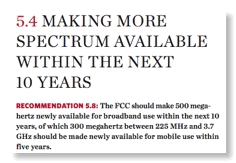How Do You Count to 500?
On February 24, 2010 Chairman Genachowski announced in a speech at the New America Foundation:
“First, we are going to announce a gameplan to unleash more spectrum for mobile broadband. The National Broadband Plan will set a goal of freeing up 500 Megahertz of spectrum over the next decade. We will work closely with NTIA to do so.”
CTIA had previously stated
So the 500 MHz no doubt was a compromise number that attempted to address reality.“we need at least another 800 MHz within six years to meet the increasing consumer demand whether it's for mobile Internet, mHealth, smart grids, or a number of other wireless uses that change the way we live and work."

Traditionally the cellular industry has used full duplex symmetrically pair spectrum. Thus the cellular 800 MHz band is 824-849 MHz (mobile-to-base) paired with 869-894 MHz (base-to-mobile). The same type of symmetric pairing was used for PCS and 3G in high bands. This was clearly necessary when the predominant use of cellular was 2-way voice which has little tolerance of time latency/delay. But the rapid expansion of mobile communication volumes predicted by CTIA and the NBP are not 2 way voice, rather they are Internet and video related - categories that are asymmetric in information flows and more tolerant in time latency. Many of these flows are also highly intermittent as compared to voice, with high peak to average data rates. Is the traditional type of allocations the best way or the only way to handle this type of growth?
Your blogger has no objection to the reallocation of 500 MHz of spectrum for the traditional paired symmetric use, but it is becoming increasingly clear to all involved that finding 500 MHz of such spectrum will be in the extremely difficult to nearly impossible range. In addition, the major need for spectrum is in major metropolitan areas and the focus on nationwide availability of spectrum ignore options. From what I have heard, the cellular establishment wants FCC and NTIA to find it spectrum that has all the following characteristics:
- Nationwide full time availability
- Paired
- In large contiguous blocks
- Consistent with international allocations and international standards (note that this is not a legal requirement except near borders with Mexico and Canada absent a bilateral agreement)
So isn’t it time to start thinking of Plan B? If 500 MHz of spectrum meeting the cellular establishment’s 4 conditions can not be found with politically acceptable impact on other federal and nonfederal uses, how would “noncomplying” spectrum count towards the 500 MHz goal? Maybe for tactical reasons the cellular establish doesn’t want to consider this possibility, but to many of us it is a quite real possibility as none of the “spectrum haves” are anxious to release their part of the 500 MHz or have any impact from its altered use, e.g. GPS/LightSquared problem.
CBO knows how to “score” budget proposals, should FCC and NTIA start thinking about how to “score” spectrum reallocations with respect to the 500 MHz goal?
[I help my international neighbors by reading in English to their 4 year old. While I was writing this post, one of the books he selected was this one.I recommend it!]
blog comments powered by Disqus




![Validate my RSS feed [Valid RSS]](valid-rss-rogers.png)

